Turning telescopes into thermometers for neutron stars
– Nirmal Raj

Image courtesy: Nirmal Raj
Whichever way you slice it, neutron stars are extraordinary. Formed as relics of supernovae, they are as dense as Mount Everest squeezed onto your fingernail, shrouded in ultra-strong magnetic fields, and protected against collapse under their own gravity via quantum mechanical pressures. They also spin around their axes with a regularity that rivals atomic clocks. Small wonder then that they are used as nature’s laboratories to enrich our understanding of several branches of physics: astrophysics, general relativity, particle, nuclear, statistical and plasma physics.
Measuring the temperature of neutron stars helps us answer central questions about them – what they are made of, their size, their mass, the behaviour of nuclei in their high-pressure interiors, and so on. Although an overwhelming majority of neutron stars are thought to be as cold as ice, the lowest temperature at which we have (or more precisely, the Hubble Space Telescope has) caught them is about 30,000 Kelvin. This is because fainter neutron stars are very hard to see.
Enter the James Webb Space Telescope (JWST). In a new study, researchers led by Nirmal Raj, Assistant Professor at the Centre for High Energy Physics, show that JWST, which has been revealing the secrets of the infrared universe for the past two years, can be turned into a thermometer of neutron stars glowing at 2,000-40,000 Kelvin.
They used JWST’s Exposure Time Calculator, an online tool provided by astronomers, to determine the sensitivities of imaging instruments aboard the telescope to the faint glow of such neutron stars. They found that if JWST could collect a day’s exposure on a neutron star, its temperature could be measured, so long as it is within 1,600 light-years of Earth. Within that distance, there could potentially lurk a hundred thousand warm, undiscovered neutron stars that may serve as observational targets.
This could unveil several mechanisms of late-stage heating of neutron stars that astrophysicists have proposed over decades, involving chemical imbalances, superfluid vortices, star-quakes, decays of the stellar magnetic field, and even energy drawn from dark matter. Even more sensitive instruments would be the future Extremely Large Telescope and the Thirty Meter Telescope, the latter of which is currently being designed with several Indian astronomers playing a key role.
REFERENCE:
Raj N, Shivanna P, Rachh GN, Exploring reheated sub-40000 Kelvin neutron stars with JWST, ELT, and TMT, Physical Review D (2024), Editor’s Suggestion.
https://journals.aps.org/prd/abstract/10.1103/PhysRevD.109.123040
LAB WEBSITE:
https://sites.google.com/view/nirmal-raj/




